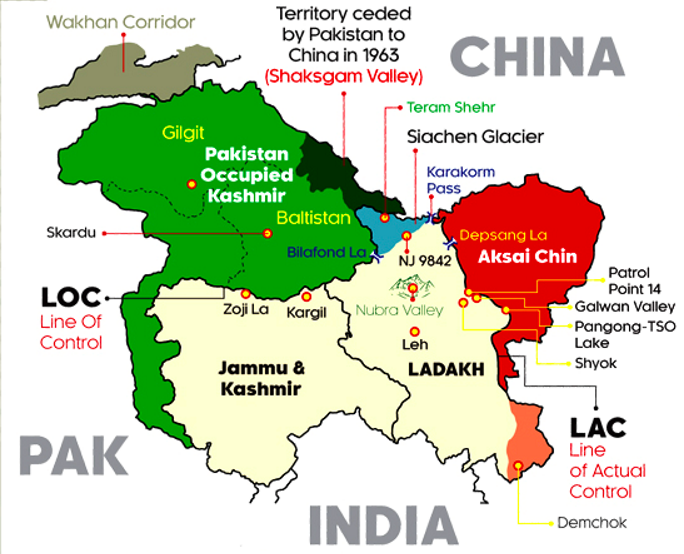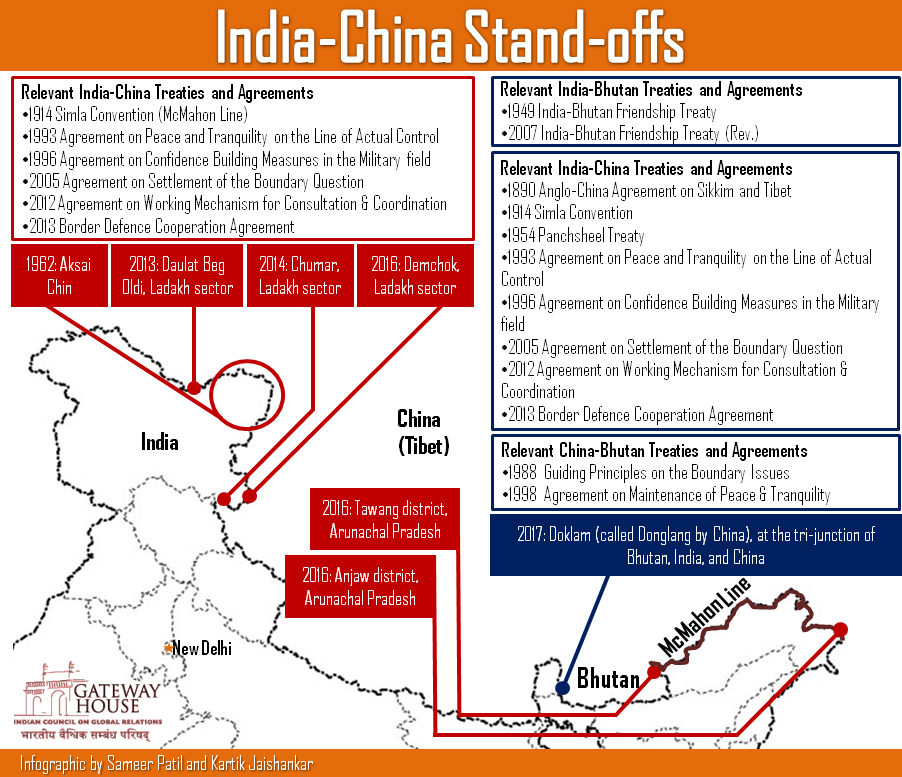International Relations
India-China Relations: Crossroads & the Road Ahead
- 02 Apr 2025
- 15 min read
This editorial is based on “China-India ties across the past and into the future” which was published in The Hindu on 02/04/2025. The article underscores that India-China relations, rooted in a shared historical legacy and shaped by evolving strategic dynamics, have navigated a complex balance of cooperation and contention over the past 75 years.
For Prelims: 2024 BRICS Kazan summit, BRICS, SCO, G-20, Asian Infrastructure Investment Bank (AIIB), India-Middle East-Europe Corridor, SAGAR strategy, ISA (International Solar Alliance), ASEAN, China+1 strategy, 2023-24 Economic Survey, PM-DevINE, BIMSTEC, IN-SPACe, ndia Semiconductor Mission
For Mains: India-China Bilateral Relations, Cooperation and Disputes.
Marking 75 years of diplomatic ties, India-China relations stand as one of the world’s most significant bilateral engagements- complex, consequential, and deeply rooted in civilisational depth. Despite recurring strategic divergences, the two nations continue to engage across trade, multilateralism, and cultural exchange. Echoing its vision, China called for an “elephant-dragon duet”- a symbolic call for peaceful, cooperative coexistence between the two Asian giants. As rising powers, India and China must now navigate this relationship through dialogue, mutual respect, and strategic balance.
How Have India and China’s Relations Evolved Over Time?
- Diplomatic Foundations: India and China established diplomatic relations in 1950, grounded in the Panchsheel Agreement of 1954.
- The agreement emphasized peaceful coexistence and non-interference, becoming a bedrock for their bilateral engagement.
- Strategic Leadership and High-Level Guidance: Over the decades, leadership meetings provided strategic direction to bilateral relations during critical phases.
- On the sidelines of the 2024 BRICS Kazan summit India and China signaled a renewed chapter in mutual cooperation.
- Economic Engagement and Trade Partnership: China remains India’s one of the largest trading partners, with bilateral trade reaching USD 118.4 billion in 2023-24.
- Despite tensions, India continues to import telecom, Active Pharmaceutical Ingredient (API), and electronic components, reinforcing economic interdependence.
- The trade relationship, though asymmetrical, reflects deep integration in manufacturing supply chains and industrial inputs.
- India also exports iron ore, organic chemicals, and raw materials, indicating a resource-driven export structure.
- Investment and Supply Chain Linkages: Chinese investment plays a pivotal role in India’s unicorn ecosystem and high-tech industries.
- In 2020, 18 Indian unicorns had received over USD 3.5 billion in Chinese investments, reflecting capital linkages.
- Cultural and Civilisational Exchanges: Historical figures like Xuanzang and Monk Bodhidharma exemplify deep cultural ties and shared civilisational ethos.
- In April 2025, Visva-Bharati University hosted a seminar marking 100 years since Tagore's visit to China.
- Ongoing academic collaborations and language learning programs have further institutionalised soft power exchange.
- China’s interest in Ayurveda, Yoga, and Indian classical arts highlights growing cultural receptivity and mutual curiosity.
- People-to-people linkages have been revitalized through the recent resumption of direct flights and visa facilitation, boosting educational and tourism exchanges.
- Defence and Strategic Dialogue: Regular Corps Commander-level meetings and the Working Mechanism for Consultation and Coordination continue.
- The 33rd Working Mechanism for Consultation & Coordination on India-China Border Affairs (WMCC) meeting, held in March 2025, saw India and China agree to prepare for the upcoming Special Representatives' meeting and enhance border management measures.
- Multilateral Cooperation: India and China actively engage in multilateral fora such as BRICS, SCO, G-20, and Asian Infrastructure Investment Bank (AIIB).
- In 2024, both nations endorsed Global South solidarity and promoted multipolarity within the SCO framework.
- Infrastructure and Connectivity: India has not joined China’s Belt and Road Initiative, citing sovereignty concerns over China Pakistan Economic Corridor (CPEC) in PoK.
- India promotes alternatives like the India-Middle East-Europe Corridor and SAGAR strategy to assert regional connectivity leadership.
- Water Cooperation and Hydrological Data Sharing: China has resumed the sharing of hydrological data on the Brahmaputra and Sutlej rivers post-2024 dialogue.
- The absence of a water-sharing treaty remains a concern, but current mechanisms ensure early warning systems.
- Border Management and Confidence Building: Mutual troop withdrawals and establishment of no-patrol zones in Gogra, Galwan, and Pangong Tso aim at stability.
- Depsang and Demchok witnessed breakthroughs in 2024, marking progress since the 2020 standoff.
- Other Areas of Cooperation: India and China cooperate in climate diplomacy, disaster relief, and global health governance through G-20 and BRICS.
- Joint efforts in UN peacekeeping, pandemic response mechanisms, and development finance signify broader strategic convergence.
- China supports India's initiatives like ISA (International Solar Alliance), and both countries have shared stakes in energy transition.
- Cooperation in multilateral banking institutions like the AIIB, and New Development Bank (NDB) reflects their regional leadership roles.
What Are Major Challenges in the India-China Relations?
- Persistent Border Disputes: The 3,488-km-long LAC remains undefined, with frequent incursions and infrastructure buildups on both sides.

- China occupies 38,000 sq km of Aksai Chin and claims 90,000 sq km of Arunachal Pradesh as South Tibet.
- India perceives China's dual-use village construction along the border as a strategy of salami-slicing territorial control (gradual, covert encroachment of territory without open conflict).
- The absence of mutually agreed maps on LAC sectors has compounded verification and patrol coordination challenges.
- Remaining friction points at Depsang and Charding-Ninglung Nala are still under negotiation.
- Galwan Incident and Trust Deficit: The Galwan clash in 2020, resulting in 20 Indian soldier deaths, triggered a strategic rupture.
- Despite multiple disengagements, trust levels remain low, hindering normalization of relations.
- Economic Imbalances and Trade Deficit: India’s trade deficit with China touched USD 85 billion in 2023-24, up from USD 83.2 billion in 2022-23.
- Chinese dominance in critical imports like APIs, electronics, and solar panels affects India’s trade leverage.
- This structural imbalance reflects India's low-value exports versus high-value Chinese imports, perpetuating dependency.
- India’s anti-dumping efforts are often undermined by Chinese rerouting through ASEAN partners under existing FTAs.
- Strategic Nexus with Pakistan: China’s CPEC runs through PoK, violating Indian sovereignty and deepening the China-Pakistan strategic nexus.
- China’s military and nuclear cooperation with Pakistan adds to India’s strategic insecurity.
- Technological Dependence: India’s smartphone market is dominated by Chinese firms with around 75% market share.
- Despite bans, many Indian Electric Vehicles and telecom sectors remain reliant on Chinese tech and batteries.
- India’s ambitions for semiconductor self-sufficiency face hurdles due to lack of technical know-how and ecosystem depth.
- The absence of a robust regulatory framework for digital hardware imports makes critical infrastructure vulnerable to disruption.
- Cyber Threats and Digital Surveillance: China-linked ChamelGang and other threat actors have targeted India’s healthcare and power grid networks.
- India banned over 300 Chinese apps and excluded firms like Huawei from 5G trials for security concerns.
- Water and Environmental Concerns: China’s upstream control of rivers like Brahmaputra and Sutlej threatens India’s water security.
- China’s mega-dam plans at Medog and earlier Zangmu Dam lack consultation with downstream India.
- Maritime and Regional Influence: China’s presence in Sri Lanka, Maldives, and Myanmar under the Maritime Silk Road and String of Pearls strategy challenges India.
- Global Forums and Diplomatic Obstruction: China consistently blocks India’s Nuclear Suppliers Group (NSG) membership and UNSC permanent seat bid.
- It shields Pakistan-based terrorists in UNSC sanctions committees, frustrating India’s global ambitions.
What Are the Latest Developments in India-China Relations?
- Diplomatic Reset in 2025: India and China marked 75 years of diplomatic ties with events and bilateral dialogues.
- A breakthrough agreement on Depsang and Demchok troop withdrawals was reached in late 2024.
- Resumption of Dialogue Mechanisms: The 23rd Special Representatives' meeting and Vice Minister-Foreign Secretary Meeting were held in Beijing in 2025.
- India and China reached a consensus on border issues and agreed to enhance practical cooperation.
- High-Level Engagements: Modi and Xi met on the sidelines of BRICS Kazan summit in October 2024.
- This was their first formal meeting in five years, signaling willingness to reset ties.
- Hydrological Data and Pilgrimage: Agreement reached to resume data-sharing on rivers and restart Kailash Mansarovar Yatra by summer 2025.
- These steps indicate trust-building and confidence restoration measures post-crisis.
How Can India and China Strengthen Their Bilateral Relationship?
- Deepen Strategic Dialogue: Both sides must maintain momentum through SR-level and WMCC talks to resolve remaining friction points.
- As India recently emphasized, the events of 2020 are not the way to resolve bilateral issues, and the path ahead lies in full disengagement, de-escalation, and restoration of peace along the LAC.
- Sustained engagement through SCO and BRICS platforms will reinforce multilateral trust and conflict avoidance.
- Balance Economic Interdependence: India should diversify supply chains via the China+1 strategy while retaining beneficial FDI inflows.
- The 2023-24 Economic Survey suggested leveraging Chinese investments to boost Indian exports to the West.
- Strengthen Border Infrastructure: Accelerate construction of strategic roads, ALGs, and surveillance assets along LAC to match Chinese deployments.
- The procurement of 31 Predator drones in 2024 was aimed at bolstering mountain reconnaissance capacity.
- Promote Maritime Deterrence: Enhance India's presence in the Indian Ocean Region through QUAD cooperation and Sagarmala initiatives.
- Recent deployments in Andaman-Nicobar and coordination with ASEAN help counter China's naval outreach.
- Lead Regional Development: Strengthen initiatives like PM-DevINE, BIMSTEC, and South Asia Sub Regional Economic Cooperation (SASEC) to build goodwill in the South Asian periphery.
- New infrastructure in Nepal, Bhutan, and Sri Lanka helps counter China’s BRI outreach in the region.
- Institutionalize Crisis Management: Develop hotlines between military commands and diplomatic channels to de-escalate future incidents quickly.
- Joint training or simulation protocols could be explored to build LAC-level crisis mitigation tools.
- Recalibrate Technology Policy: Build indigenous capacity in semiconductors, APIs, and solar equipment under PLI and Digital India.
- The IN-SPACe and India Semiconductor Mission are vital to reduce Chinese tech dependency.
- Cultivate Strategic Autonomy: Balance US and QUAD ties with non-alignment principles, while maintaining core interests with China.
- A multipolar Asia needs India to act as a civilisational balancer, not a proxy within geopolitical blocs.
Conclusion
As India and China step into the next phase of their diplomatic journey, sustained dialogue, strategic maturity, and cooperative multilateralism will be essential. By aligning shared interests with global responsibilities, both nations can shape a stable, multipolar Asia and contribute meaningfully to a more equitable international order.
|
Drishti Mains Question: “India-China relations are marked by cooperation, competition, and confrontation.” Critically examine this trilateral dynamic in the current geopolitical context. |
UPSC Civil Services Examination Previous Year Question (PYQ)
Prelims
Q. “Belt and Road Initiative” is sometimes mentioned in the news in the context of the affairs of : (2016)
(a) African Union
(b) Brazil
(c) European Union
(d) China
Ans: D
Mains
The China-Pakistan Economic Corridor (CPEC) is viewed as a cardinal subset of China’s larger ‘One Belt One Road’ initiative. Give a brief description of CPEC and enumerate the reasons why India has distanced itself from the same. (2018)





